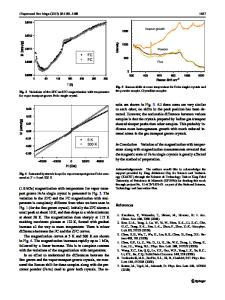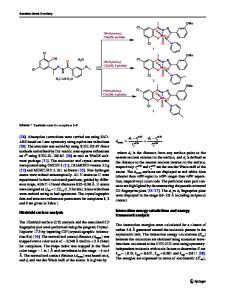Crystal structures and magnetic properties of manganese(II) and nickel(II) complexes constructed from 1,3,5-tris(carboxy
- PDF / 1,415,765 Bytes
- 7 Pages / 595.276 x 790.866 pts Page_size
- 35 Downloads / 292 Views
Crystal structures and magnetic properties of manganese(II) and nickel(II) complexes constructed from 1,3,5‑tris(carboxymethoxy) benzene acid ligand Wei‑Li Wu1 · Jian‑Peng Dong1 · Ke‑Cheng Liu1 · Yu‑Jie Jin1 · Bo Li1 · Li‑Ya Wang1 Received: 7 July 2020 / Accepted: 26 August 2020 © Springer Nature Switzerland AG 2020
Abstract Two coordination polymers, namely {[Mn2(HL)2(bpe)(H2O)8]·5H2O}n (1) and {[Ni3(L)2(bpe)3(H2O)6]·3H2O}n (2) (H3L = 1,3,5-tris(carboxymethoxy)benzene, bpe = 1,2-bis(4-pyridyl)ethylene), have been hydrothermally synthesized. In L2− ligands into rings. Adjacent rings are linked through hydrogen bondcompound 1, two M n2+ ions are linked by two H ing between carboxylic groups and water molecules to produce a three-dimensional supramolecular network, which shows channels along the b axis that are occupied by the free bpe molecules. Compound 2 possesses a 3D architecture, constructed from Ni-bpe chains and L3− linkers. The 3D architecture is further consolidated by the hydrogen-bonding interactions. The magnetic properties of complexes 1 and 2 have been investigated. Antiferromagnetic interactions were observed for complexes 1 and 2.
Introduction As organic and inorganic hybrid materials, coordination polymers combine the rigidity of inorganic materials with the flexibility of organic ligands, making them widely used in gas adsorption and storage [1–4], photocatalysis [5–7], proton conduction [8–10], etc. Nowadays, most of coordination polymers are based on the rigid skeleton [11, 12]. The flexible ligands can exhibit different conformation and coordination modes according to the geometric requirements of different metal ions and provide unpredictable and Electronic supplementary material The online version of this article (https://doi.org/10.1007/s11243-020-00423-7) contains supplementary material, which is available to authorized users. * Bo Li [email protected] * Li‑Ya Wang [email protected] 1
Key Laboratory of Ecological Security for Water Source Region of Mid‑line of South‑to‑North Water Diversion Project of Henan Province, Henan Province Collaborative Innovation Center of Water Security for Water Source Region of Mid‑Line of South‑to‑North Diversion Project of Henan Province, College of Chemistry and Pharmaceutical Engineering, Nanyang Normal University, Nanyang 473061, People’s Republic of China
interesting supramolecular networks [13, 14]. In addition, the noncovalent interactions (hydrogen bonding, π–π interaction or halogen bonding) are one of the well-established essentials of crystal engineering [15, 16]. However, research on the reactivity and coordination chemistry of such flexible ligands is still necessary, and research based on coordination polymers still pose great challenges. To construct coordination polymers, we choose a tripod ligand 1,3,5-tris(carboxymethoxy) benzene (H 3L) (Scheme 1). H3L ligand possesses a rich variety of coordination modes, which may be completely or partially deprotonated upon a change to pH and help to assemble coordination polymers; on
Data Loading...











